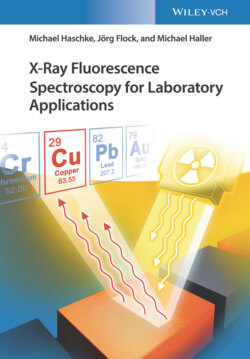Читать книгу X-Ray Fluorescence Spectroscopy for Laboratory Applications - Michael Haschke, Jörg Flock - Страница 13
2.2 X-ray Radiation and Their Interaction 2.2.1 Parts of an X-ray Spectrum
ОглавлениеX-radiation is electromagnetic radiation in the energy range of approximately 0.1–100 keV or with wavelengths in the range of approximately 25 to 0.01 nm. X-radiation is therefore characterized either by its energy E or by its wavelength λ. Both quantities are mutually transferable through the following relationship:
(2.1)
X-ray radiation can be generated by several processes. A continuous broadband spectrum is emitted by the stepwise deceleration of highly energetic charged particles but also by highly ionized plasmas (bremsstrahlung). Line-like spectra (characteristic radiation) are generated when transitioning excited atoms back into the ground state, if the energy difference of the energies involved is within the range described above. For the excitation of X-rays in the laboratory scale, accelerated charged particles, i.e. electrons or protons, as well as high-energy ionizing radiation, i.e. X-rays themselves are used. In the beginning, radioactive elements were also used as radiation sources in laboratory equipment. However, these sources are now used not very often because of the high safety requirements.
The most common way of producing X-ray radiation is the deceleration of accelerated electrons. This is used in X-ray tubes and electron microscopes. The deceleration of the electrons results in both a continuous spectrum and a line-like spectrum.
The continuous spectrum results from the deceleration of the electrons on the tube target by scattering on the atomic nuclei. The intensity of the emitted radiation is described in detail by Kramers' law.
(2.2)
with
| I cont | intensity of the emitted radiation |
| K | proportionality coefficient |
| I | electron current |
| Z | atomic number of the decelerating material |
| E 0 | maximum energy of the electrons |
If this process is carried out in an X-ray tube, the generated radiation must be directed at the sample through an exit window. The exit window of the tube absorbs the low-energy parts of the primary spectrum. This process is described by the following addition to Kramers' law, in which μ is the mass attenuation coefficient, ρ is the density, and d is the thickness of the tube window:
(2.3)
The proportions of this relation are shown in Figure 2.1. It shows the continuous spectrum (emission) generated at the target, the low transmission through the tube window in the low-energy range (transmission) as well as the resulting radiation emitted by the tube (tube output).
In addition to the continuous radiation, there are also line-like spectral components in the energy range of X-rays, which are generated by electron transitions in an atom. For this purpose, an internal electron level must be ionized by an energy input, which is higher than the binding energy of the electron. This excitation is possible by radiation, i.e. electron, proton, or even X-rays themselves or by the generation of a high-energy plasma. The resulting electron vacancy in an inner shell is filled by electrons of outer shells, in order to transfer the atom to a stable state again. These transitions can occur from different electron levels, resulting in a series of X-ray lines being emitted. The energy level differences depend on the type of the emitting atom; therefore, this radiation is called the characteristic radiation. The labeling of these lines starts with the designation of the primary vacancy, i.e. when the innermost K-shell is ionized it is K-radiation, when the L-shell is primarily ionized it is L-radiation, etc.
Figure 2.1 Parts of the continuous spectrum of an X-ray tube.
Figure 2.2 Line energy as a function of the atomic number.
The energies of the electron levels depend mainly on the number of protons of the atom, i.e. on the atomic number. This means that the energy differences depend on the type of the atoms. These energy differences are described by Moseley's law.
(2.4)
with
| E | = | energy difference between the electron levels |
| Z | = | atomic number of the atom |
| C1, C2 | = | constants |
This relation is shown for different lines as a function of the atomic number in Figure 2.2. Detailed information can be found in Tables A.4–A.9.
Figure 2.2 shows that the energy of the characteristic radiation increases with the atomic number; it also shows that the line energies of an element decrease from the K series over the L series to the M series, and that in the energy range of approximately 1–40 keV, which is commonly used for X-ray spectrometry, almost all elements emit their characteristic radiation. Exceptions are only elements with very low atomic numbers (Z ≤ 7).
